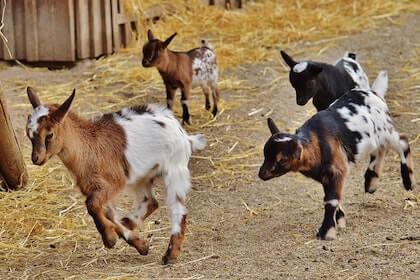Goats have many economic benefits to man and they are an integral feature in the animal farming industry. In addition to being bred for meat and dairy, goats are also kept as pets.
No matter your reason for rearing goats, you will want them to be healthy as they won’t be much good to you otherwise. Being able to tell when a goat is healthy and when it is sick could be the difference between a competent farmer and one with a high death rate on their farm.
So, how can you tell if your goat is in perfect health or if something is wrong?
You can tell a healthy goat by physically examining the goat regularly. A healthy goat will display appear a certain way and any changes in the physique can indicate a problem. In addition to physical examinations, you can also tell a healthy goat from its behavior.
These traits are usually common to most goats and any change in it can be an indication that something is wrong. There are many factors to consider, so, you may want to consult a veterinarian whenever you feel something is off.
What Should you Expect from a Healthy Goat?
When you understand that a change from the normal can mean something is wrong with your goat, then you have to wonder, what is normal? As goats are creatures of habit, you can expect some level of consistency from them.

After all, they are used to the daily routine and any changes in their environment can affect them. However, there are some things you should expect from a healthy goat that will indicate its good health status.
Physical Attributes
The physical attributes are the most obvious things you first notice when you look at a goat. This makes it the fastest way to detect if your goat is healthy or not.
Some physical attributes you can expect from a goat include:
Full-body hair
Goats are very hairy animals, with hair covering almost everywhere on a goat, even encroaching into some openings.
It is alright for younger goats to have bald patches or areas that aren’t yet covered with hair as that will change with time. However, what is uncommon is for a healthy adult male to lack hair in areas on his body.
If you have a goat that seems to be losing hair on its body, then you may want to contact a vet. You should however consider the age of the goat, as older goats can also lose hair with time.
Just as an older person may start to go bald, so too, an older goat may start to lose some of its hair. If the hair loss is minor, then there may not be any need to worry
However, if the goat has bald patches all over its body or even patches of total hair loss, then you should consider getting it checked by a vet.
A soft and wet nose
A goat’s nose is usually soft and wet all the time even when they aren’t close to any water sources. It is however important to note that while the nose is constantly wet, it does not discharge water or any kind of fluids.
If you notice any discharge from the nose, then there is probably something wrong with the goat.
Similarly, the nose should normally be wet and when you notice one that is dry or cracked, then the goat is probably sick. A dry nose can indicate a goat that is dehydrated, while a cracked one may mean the goat has been exposed to cold
Healthy goats have pink tongues that are free of cracks or sores. This is especially important for older goats who tend to develop some cracks on their tongues, so you shouldn’t worry too much.
Either way, you will need to contact your vet.
Pink gums
Same as with humans, goats are supposed to have pink gums and this is an indication of health.
Anything contrary to this, and there is something wrong with the goat. It may not be easy inspecting the gums of several goats but it can serve as an indication of health.
Likewise, the breath of the goat can also be a good indicator of its health. It may not be pleasant but sometimes, infections can make a goat’s breath worse and you can tell just by perceiving its breath. A healthy goat’s breath should not have a foul odor.
Bright and clear eyes
Healthy goats have clear eyes that are free from any discharge or crusts. In addition to this, goats have a different color of eyes same as humans but one thing remains constant, their eyes are always clear.

Keep an eye out for any discharges in the eyes as they can be an indication of disease. It should be worth noting that the gooey discharge that comes out of the eye is normal.
Watery eyes, on the other hand, are not and can be your indicator that there is something wrong with the goat.
Red eyes are also another thing to look out for in the eyes. Any discoloration in the white section of the eye can be an indication of an infection. The same goes for the cornea. A healthy goat’s cornea is free of any adhesions and is also clear. Corneal adhesions can form as a result of injury or infection; however, they may also be hereditary
You can avoid such by always checking the eyes of the goat to see if they are clear and also focusing on the consistency of its tears. A healthy goat’s eyes will have a balanced secretion of fluid, with no excess or lack thereof
Dry or pale skin
A goat may have a dry skin for various reasons but it usually has something to do with the breed. The Bezoar breed is known to have a very dry skin, not to mention a coarse one
There are some breeds whose skin is so dry that they have a flaky appearance. In this case, a goat with a dry and flaky coat may be suffering from an illness or it may be going through the shedding process.
Behavioral patterns
Goats will always behave in certain ways once they are healthy. It is so consistent that it is normally the same routine day after day, except for when hormonal factors come in.
Any deviation from the life of a goat that isn’t in line with mating habits can be an indication of a problem. This will include things like the goat not eating, staying still for too long, loss of appetite or even limping.
Visible physical deformity
An easy way to tell if a goat is healthy is by looking for physical deformities. This can be something as simple as deformed ears to an obvious deformation on their legs
This can be a sign of inbreeding or even malnutrition, among other things. Of course, this is only if the deformity cannot be corrected through surgery. If it can, then you might want to call your vet immediately because the goat may need medical attention.
High levels of aggression
Goats are naturally very aggressive and will always seek to display this. As part of herd hierarchy, you may notice goats fighting amongst themselves or charging at each other horns up.
Outside herd politics, a goat will attack anyone or anything when it feels threatened, no matter the size of the intruder.
This is all-natural and an indication that a goat is healthy. However, should you notice a goat shying away from a duel, then it may be a problem. Fortunately, this can be fixed by providing it with enough food. You may also notice some changes in its behavior once it is well-fed.
Group Movement
Goats are herd animals and they tend to do everything together. From grazing and interaction to sleeping, goats will do all these in a group.
If a goat spends time in isolation, then there may be cause for worry. A brief hiatus may not mean anything, but a longer absence is usually a sign that something is wrong.
The longer the goat stays isolated, the more worried you should be. If you notice that a goat’s group always stays at a certain distance from or avoids it completely, then there may be a cause for alarm.
Injuries and wounds
It is expected for goats to get wounded from time to time, but this should never be ignored. A wound can make the goat prone to bacterial infection among other things.
In this case, you should always monitor the wound and be ready to call your vet in case things get worse. You should never patch a goat’s wound yourself because it may lead to an infection.
Urinating and defecating frequently
Most goats have no decorum and do whatever they like, whenever they like. This is including and is not limited to, urinating and defecating anywhere, even where they sleep.
To make matter worse, this is a part of some of their mating rituals, as a male goat will pee on his hooves to be more attractive to females.
Females, on the other hand, pee as an invitation to male goats, leaving traces of pheromones in their urine. If you don’t notice this amongst your goats, then you should be concerned.
Goats can also pee and defecate a lot depending on their diet. Some plants are not suited for goats and that leaves undigested food in their stomachs, which then produces gas that needs to be released as soon as possible.
Bleating and screaming
Bleating and screaming are common among goats especially when it is in soft tones. It can also serve as an indicator that a goat is in pain and is simply crying out.
Healthy goats bleat and scream in a certain way and should the tone or pattern change, then you can assume something is wrong.
Visible signs of disease
Your goat may also show visible signs of disease. This can include things like weight loss, rashes, and even hair loss. Unfortunately, this is not always the case especially when the condition develops slowly over time.
Keep in mind that many diseases are contagious and can spread to other goats easily.
Final Thoughts
Other factors like age and the breeds of the goat may make the behavior and physical attributes of the goat different.
You should however be able to tell when your goat has or is doing something different from the normal. Call your vet if there is anything you cannot understand and hopefully, it will be nothing serious.


